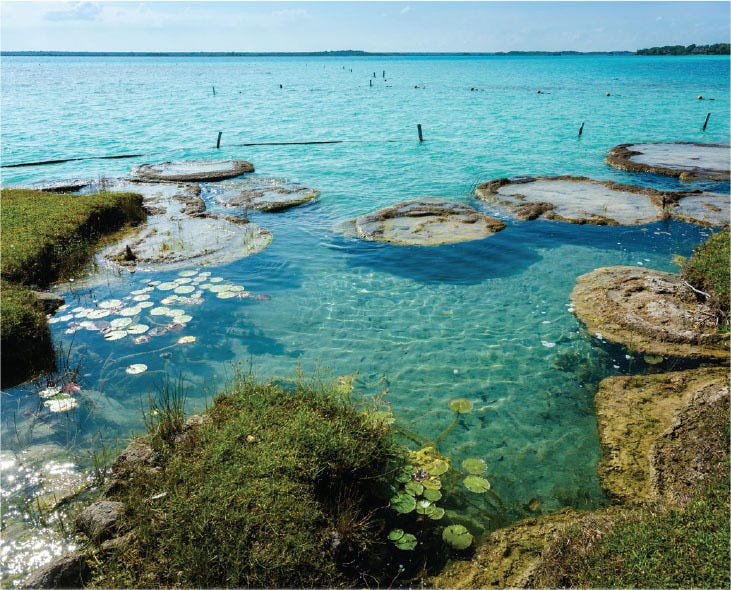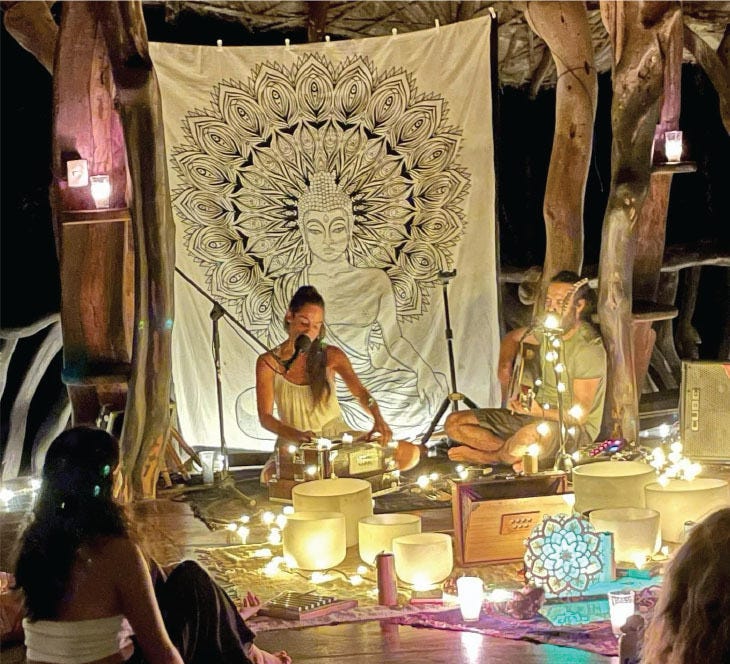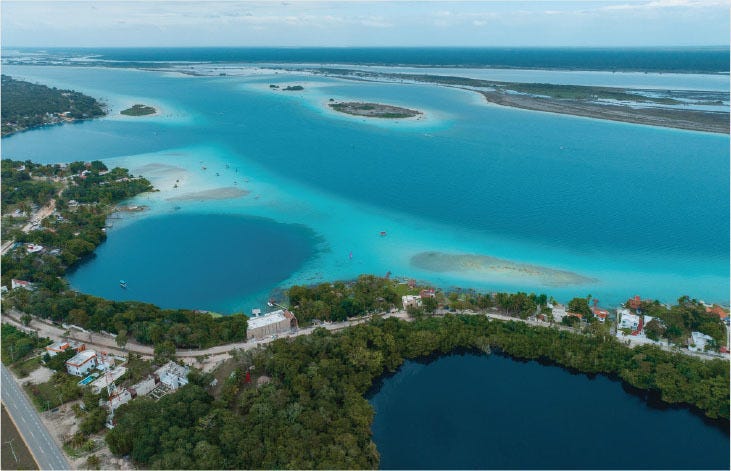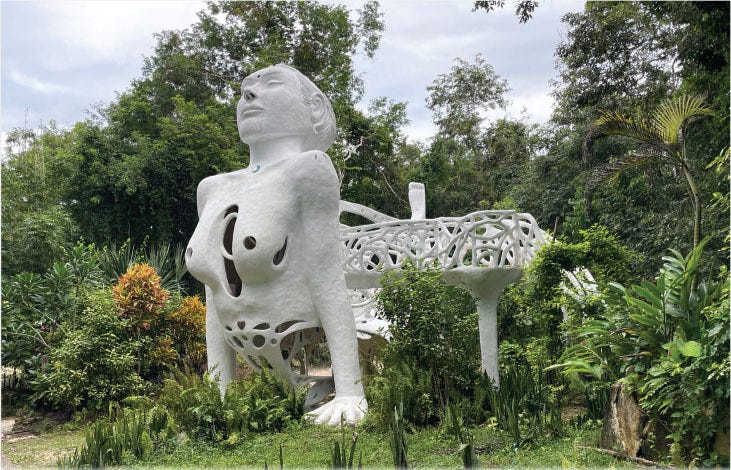Visit Bacalar’s Zen-Inducing Lagoon of Seven Colors
Escape to this 34-mile lagoon for adventure sports, gourmet cuisine, and some serious relaxation.
Bacalar Lagoon feels like a secret that’s too good to share, but impossible to keep.
According to Mayan legend, the gods used it as a palette to experiment with hues, saturating its waters with a spectrum of blues.
The 34-mile lagoon surrounded by jungle, mangroves, and small hotels, lies in Mexico’s Yucatan Peninsula, near the border of Belize.
The moment you arrive, you feel its heartbeat: slow, steady, and soothing. The lagoon doesn’t just invite you to relax—it demands it.
I was there for work, and even the conference evoked a sense of calm. This place changed my definition of “zen.”
When my husband Mark joined me, I was ready to dive deep into the lagoon and all the Bacalar region offers. This is one of the most tranquil places on earth, but make no mistake: There’s an inordinate amount for the adventurous to see, do, and taste…
A Natural Masterpiece
Bacalar is known as the “Lagoon of Seven Colors” because there are so many different shades of blue, thanks to its cenotes, underground sinkholes within the lagoon. The deeper the cenote, the deeper the blue.
The aptly named Cenote Negro, also known as Cenote de la Bruja (the Witch’s Cenote) is a perfectly circular black hole in the middle of the lagoon.
The massive Cenote Esmeralda—measuring more than 1650 feet across—is an intense teal.
Outside the cenotes, much of the water is shallow and brilliant cyan. The lagoon bed is covered in powdery white limestone, contributing to the light Caribbean blue you’d expect from the sea.
The stromatolites are also a factor—these are the oldest living fossils on earth, dating back three billion years.
These particular organisms look like massive flat-topped mushrooms and release oxygen into the water to help clean it.
Together, these natural wonders create a kaleidoscope of blues, making Bacalar’s lagoon a masterpiece.
If you’re a water baby (and you probably are if you’re visiting this area), you could spend lazy days kayaking or stand up paddleboarding at your own pace. Or you can opt for a bit more adventure with surfing, eFoiling, diving, and sailing. If you can do it on the water, you can do it in Bacalar.
Out on the Lagoon
On our first day, we took a pontoon boat out for a midday tour and barbecue with Daytour Bacalar. As we putted around the calm turquoise waters, our guide explained each section. The cenotes, the colors, the stromatolites.
Our first stop was near Pirate’s Canal, where over 400 years ago pirates used this ancient Maya waterway as their gateway to embark on raids against the unsuspecting city. We hopped into chest-high tepid water and strolled around with a beer in hand.
Then we pulled anchor and scooted over to our next spot, a little deeper and more of a cobalt blue. Our trusty captain was also a pretty skilled chef who made us a BBQ of shrimp and beef skewers with chimichurri, guacamole, and chips… all part of the tour.
After hanging out there for a while, we set our sights back on dry land, feeling like we just won the day.
Beach Clubs and Sunsets
After day drinking, we needed a nap.
Even though there’s no sand to be found in Bacalar, any establishment with lounge chairs, hammocks, or a dock for chilling out is called a beach club. Your hotel may have one, but even if you’re staying in town off the waterfront, you can spend the day at one.
La Playita is super popular. It has a chilled-out vibe and great food, so when you aren’t in the lagoon, you can grab some tacos.
For a higher-end option, head to Bacalar Beach Club. It has a pool, water hammocks, and lounge chairs, as well as a mixologist, DJ, and restaurant.
Most beach clubs stay open past sunset, some well into the evening. Stay for sunset. You’ll never regret ending the day watching Mother Nature do what she does best in one of the most breathtaking places in Mexico.
Tranquility in the Mist
The next morning, we rose at o-dark-thirty and walked down to the dock of our hotel, Boca de Agua, with only the stars to guide us.
After a few minutes of getting used to the lack of light, we realized our first time on a paddleboard would be in complete darkness. We laughed nervously, but after a 15-minute lesson and a lot of reassurance, our guide, Cesar, gently pushed me into the middle of the lagoon and told me to wait there. Where was I going? I had no clue how to go anywhere, let alone in the dark.
I was sitting there in the pitch black, looking for small insects on the water’s surface and hearing the flapping of bird or bat wings as they fluttered near my head. I tried to remain calm (I’ve been attacked by a bird before).
A few minutes later, Cesar called out to me and told me to follow his voice. Which, for a newbie paddleboarder, was surprisingly easy. I expected to be paddling in circles.
Thankfully, the water was like glass (which was why paddling was so easy) and the only sound we heard was the swishing and swooshing of our paddles gliding through the water.
As the night turned into dawn, an eerily peaceful fog settled on the water and mangroves, adding to the zen-like ambiance of being the only people on this area of the lagoon.
We tied up the paddleboards and watched Cesar open his backpack and set up a picnic on my board. Fresh fruit, homemade breads, and sumptuous chocolate-orange cake, all washed down with hot creamy coffee.
With only the sounds of the water curling around the reeds and the occasional bird landing in the misty mangroves, we felt like we were in a meditative Japanese water garden. We shared some mango with the resident black-striped fish and watched an elegant white heron hunt for his breakfast.
After breakfast, we begrudgingly untied and started our paddle home.
We never saw the sun rise. Or any sun at all. Yet in the stillness of the morning, as nature slowly stirred awake, it felt as if the world had paused just for us. The serenity and connection to those few quiet early hours were more profound than any sunrise could have been.
The Need for Speed

After waking up at 5 a.m. and paddling nearly four miles, we decided a nap was in order. Plus, we had to conserve our energy for the next watersport activity. After all that peaceful zen-ness, we were in the mood for some adrenaline.
An e-foiling lesson ($123) with Adventure Lab was just what we needed.
An e-foil looks like a boogie board, but it’s motorized and has a fin on its underside. You control it with a handheld trigger.
With practice and balance, the mission is to stand up on the board. As you pull the handle, it speeds up—and if you’re still on it, the board comes up out of the water. Essentially, you’re standing on a boogie board, flying through the air at speeds up to 25 mph…
Until you aren’t, and do a loop-de-loop belly flop into the water. Then, you drag your tired self back on the board and try again.
It’s exhausting and exhilarating, and I’m dying to try it again.
Eating Love
What you might not guess about the Bacalar region is it’s also a food lovers paradise. If you choose, you can do nothing but take in the beautiful surroundings while sampling five-star cuisine.
Nixtamal is a hot spot known for its unique take on traditional Mexican dishes. An elevated dining experience that could rival any high-end restaurant in Chicago, it didn’t disappoint.
When the chef came out to deliver our beautifully plated dish of Axiote Shrimp ($26), he said, “The most important ingredient is love.” And it showed.
The love was tangible—woven into every plate. The plump shrimp were grilled and then painted with a deep red sauce that was smoky yet delicate, and served with segments of charred grapefruit and a passionfruit crema drizzled in a tic-tac-toe formation on the plate.
A beautifully minimal restaurant with different tasting menus is Costera 28. I recommend the sixcourse taco tasting with five different tacos and a dessert. The tacos will likely have at least one that is offal, like gizzard tacos with yogurt and mint, or pig face! ($27 to $56).
You can also eat a la carte, like we did. The tortilla soup is luscious and silky, topped with crunchy chicharrones, and served in a wooden molcajete, or mortar. We also ate the Sea Ajillo, a shrimp and octopus stew drenched in a guajillo sauce served with homemade tostada chips, potatoes, and mushrooms.
And since we weren’t that hungry… we decided to order more. We thought a side of smoked vegetables served in a sealed jar full of basil smoke would round out the night.
Boca de Agua Treehouses
If you want to stay on the lagoon but away from town, head to the incredible Boca de Agua, where you’ll find ultraminimalist but restful treehouses in the jungle with all the amenities you’d want in a luxury hotel.
When I say treehouse, a rickety hut on stilts may come to mind. But that couldn’t be further from these luxury free-standing villas with a Japanese aesthetic.
All the rectangular treehouses are built on stilts to minimize their impact on the region’s flora and fauna. The designers created it so the local coatis (a racoon-like mammal) and monkeys could still feel at home there as much as people are meant to.
After walking up the set of staircases to our treehouse, we opened the door to a magical aura of light shining through the wooden slats into stripes on the floor. I was excited by the two-person woven hammock dappled in the sunbeams, but it was our private plunge pool that truly captured my attention. It was just begging us to skinny dip.
The air-conditioned bedroom had a clean, modern aesthetic with ample storage to hide away luggage and plenty of closet space for hanging. The kingsize bed, too, was threaded in light from the wooden slats fitted over the glass windows.
The outdoor shower had lagoon-blue tiled plant boxes overflowing with a purposefully planted jungle for privacy. The only audience I had while under the rainshower was a large frog.
Spending a few days in such a glorious treehouse would have been enough for us. However, there is so much more to Boca de Agua.
Besides being right on the lagoon, it has a large pool with hammocks over it and a movie screening area with comfy bean bags to lounge in.
Chef Charlie at the onsite restaurant, Flora, is a creative genius and a reason to go to Boca de Agua even if you aren’t staying there. He was raised on a farm in Veracruz, and learning what to do with all of its products is his passion.
Trained in Tulum by Michelin-star chefs, he opened a restaurant in Ghana, then returned home with new skills and an enhanced palate, eventually landing at Boca de Agua.
What we ate was soulful art disguised as food.
We ordered a jicama salad—sounds basic, right? But what we got was a thing of beauty. It was a ring of chopped jicama and mangos, with segments of pink and white grapefruit in a rosy-hued hibiscus vinaigrette laced with pickled mustard seeds and topped with peppery leafy greens. It was refreshing and bright, and the briny mustard seeds popped with every bite ($11).
It was such an elegant and refined dish that after a few bites, we called the chef over to chat about it. It’s haute cuisine in the middle of the jungle in Mexico and some of the best food we’ve had in the country.
A Sound Bath at a Seussian Temple
On Wednesday nights, at a temple plucked from Dr. Suess’ whimsical mind—everything rounded and drooping like a house built inside a mushroom—there is a free sound bathing session.
The entrance to the temple is a threestory-high white sculpture of a woman doing the cobra yoga stretch. She’s hollowed out with strategic cut outs so you can climb inside and take in the view.
As first-time sound bathers, we had no expectations or pre-judgments. Truthfully, I didn’t even know what it was when we decided to do it. I figured it was some woo-woo kind of ceremony that would lull me into good vibrations, and I’m always up for good vibrations.
We lay on yoga mats in the candlelight as a bearded man sitting cross-legged on the floor softly strummed a guitar. Fairy lights were wrapped around every surface, adding to the warm and woozy ambiance.
For the first hour, a stunning brunette in a gauzy white dress floated around tapping the crystal bowls in her hands. The sounds this creates are meant to travel through your body and reduce anxiety and stress.
With the guitar as a background and her voice flowing like honey, I felt beautifully, wonderfully stress-free. I found my inner woo-woo.
The second hour of the session, when the chanting began, it started to go a bit off the rails. Everyone was belting out heartfelt words, eyes shut, lost in the spirit of it all. Some people were standing and swaying, hands in the air.
Mark and I had no idea what we were chanting (in Spanish). We definitely would have lost in a lip sync battle.
Now I know sound bathing is my kind of woo. Chanting, not so much.
Head to Akalki to find your own woo.

— Kirsten Raccuia shares her expat adventures and insights on her blog, Sand in My Curls. After nine years in Penang, Malaysia, she traded laksa for tacos in Puerto Vallarta.
How to Get to Bacalar
Bacalar is about three hours south of Tulum, an hour inland, and delightfully off the radar… for now. Pretty soon, the new Maya Train will be chugging right through the region on its way to Belize, just a short one-hour drive away.
At the moment, flying into Chetumal, the capital of Quintana Roo, is your best option. Because it’s such a small airport, you’ll probably have to connect through Mexico City. But it’s only a two-hour flight from there.
Then hop in a taxi, Uber, or rental car to complete the 45-minute drive to Bacalar.
We rented a car, which I recommend because the lagoon is so long, and there are lots of places to visit along its shore. However, the town of Bacalar is rather small, and easily walkable if you’d rather rely on taxis or Uber.
Bacalar is a bit incongruous. On the one hand, it’s this traditional Mexican town with pot-hole-filled gravel roads lined with colorful homes and crowing roosters. On the other, it has high-end hotels and restaurants that wouldn’t be out of place in any large US city.
Mark and I couldn’t figure out what caused the immediate sensation of zen when we arrived in Bacalar, but after a few days, we realized that even the locals exuded a sense of calm. It’s like everyone who lives there breathes at a different pace—one I could get used to.
Editor’s Note: This story first appeared in the pages of International Living magazine. Want more tales and expert insights like this? Click here to learn more.




